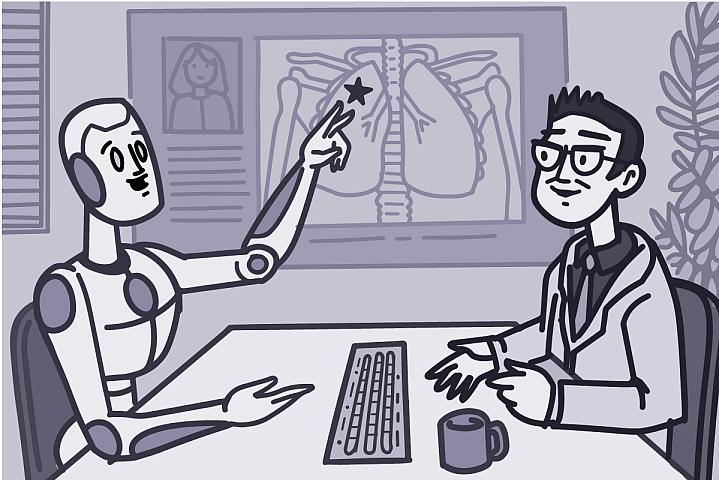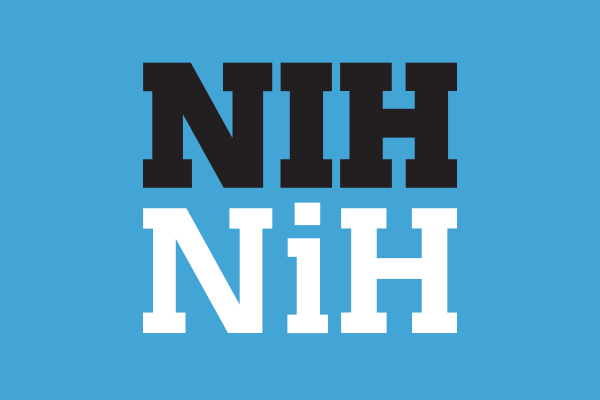Artificial Intelligence and Your Health
How Computers are Helping Medicine

There’s a lot of talk about artificial intelligence, or AI, these days. AI is everywhere—from virtual assistants to facial recognition software. The technology is even assisting doctors and scientists. So what exactly is AI? And how is it helping advance scientific research?
“AI is basically trying to teach computers to ‘think’ in the same way as the human brain,” says
Dr. Despina Kontos, an AI researcher at Columbia University.
One approach to AI uses a process called machine learning. In machine learning, a computer model is built to predict what may happen in the real world. The model is taught to analyze and recognize patterns in a data set. This training enables the model to then make predictions about new data. Some AI programs can also teach themselves to ask new questions and make novel connections between pieces of information.
“Computer models and humans can really work well together to improve human health,” explains Dr. Grace C.Y. Peng, an NIH expert on AI in medicine. “Computers are very good at doing calculations at a large scale, but they don’t have the intuitive capability that we have. They’re powerful, but how helpful they’re going to be lies in our hands.”
Researchers are exploring ways to harness the power of AI to improve health care. These include assisting with diagnosing and treating medical conditions and delivering care.
Mining Medical Images
One area that AI is already being used daily is medical imaging. Computers help doctors comb through CT and MRI scans for signs of problems like heart disease and cancer.
“AI can look at images very closely, in a way that’s much more detailed than we can do with the human eye,” Kontos says. That means that the computer may be able to pick up on subtleties that a person might miss.
In medicine, catching early signs of certain diseases can be the difference between life and death. Kontos and her team are testing ways AI can be used to identify women who are at high risk for developing breast cancer. They’re using AI to analyze different features in mammograms—X-ray pictures of the breast—such as breast density. Women who have a higher risk of breast cancer can take preventative steps, like more frequent screenings. This approach could help lead to earlier diagnosis and more successful treatment.
The team is also testing whether they can use AI to individualize breast cancer treatment based on imaging results that show how breast tumors are responding. AI may better reveal who needs more intensive treatment, like chemotherapy, and who can safely skip it.
“That way, we could spare women who don’t need intensive treatment from unnecessary side effects,” Kontos explains.
Connecting People With Care
Over the last year, advanced “chatbots,” like ChatGPT, have burst on the scene. These AI programs are designed to have realistic conversations with people. People are starting to use the technology to find health information.
Many chatbots are a form of “generative AI.” This type of AI can create new content based on what it learns from analyzing existing data. Such chatbots use what’s called large language models, which are trained on huge data sets that are gathered from across the internet. The training teaches them to predict what words are most likely to appear after another.
It may be tempting to ask these tools to answer medical questions. “But these chatbots don’t actually understand what you’re asking,” Peng says. “They’re just looking at the phrases and making predictions about what comes next.” So it’s important to use caution if you’re using them to seek health advice.
“These tools also don’t have a lot of context,” explains Dr. Ellen Fitzsimmons-Craft, a mental health researcher at Washington University in St. Louis. “They may be able to state something that’s the right medical advice in a general sense. But that may not be the right medical advice for you personally.”
“We don’t always know what information these tools like ChatGPT are trained on,” Fitzsimmons-Craft adds. “We don’t know if they’re getting information from reputable sources or not.”
Still, the idea of using chatbots in medicine has promise, explains Fitzsimmons-Craft. Right now, there is a shortage of health care providers in many fields, including mental health. Chatbots may be able to fill in some gaps.
“Not many people follow through with recommendations provided after a mental health screening,” Fitzsimmons-Craft says. “And we don’t have enough providers to connect with every one of those people.”
Fitzsimmons-Craft and her team are developing a chatbot to help guide people with eating disorders toward seeking care. Their chatbot is made using a rule-based model, with limited AI. Rule-based means that human experts write entire conversations beforehand. Then, the chatbot picks what to say based on the responses of the person using it.
“Nothing this chatbot says should come as a surprise,” Fitzsimmons-Craft explains. “That’s in contrast to generative AI, where you have to work a lot harder to build in guardrails.”
Her team is now testing their chatbot to see which conversation pieces are the most effective. They’ll then test whether it can increase the number of people seeking help after a screening for eating disorders.
Other NIH-funded researchers are studying whether chatbots can help in additional areas, like suicide prevention and encouraging heart-healthy diet changes.
Looking Toward the Future
As AI moves into more areas of health care, many ethical issues will need to be addressed, explains Kontos. “These systems learn from human data, so they may learn our biases,” she says.
For example, in the past, research studies have included far more men than women. This means that the resulting data may not be as accurate for guiding women’s health care. So, if this information is fed into AI models, that bias will follow.
Recognizing biases before they reach the machines may provide a chance to break this cycle. “Can we end up training the machines better because we learned from the mistakes that we have in our own society about training people?”
Peng asks.
NIH-funded researchers are working on these issues, as well as many other ways to use AI in medicine. These include modeling the ways a virus might spread between countries and predicting if new drugs will be safe.
All of these projects need human imagination and computing power. So AI is not a replacement for people, says Fitzsimmons-Craft. “AI is just another tool in the toolbox, that’s offering another form of help.”
NIH Office of Communications and Public Liaison
Building 31, Room 5B52
Bethesda, MD 20892-2094
nihnewsinhealth@od.nih.gov
Tel: 301-451-8224
Editor: Harrison Wein, Ph.D.
Managing Editor: Tianna Hicklin, Ph.D.
Illustrator: Alan Defibaugh
Attention Editors: Reprint our articles and illustrations in your own publication. Our material is not copyrighted. Please acknowledge NIH News in Health as the source and send us a copy.
For more consumer health news and information, visit health.nih.gov.
For wellness toolkits, visit www.nih.gov/wellnesstoolkits.



